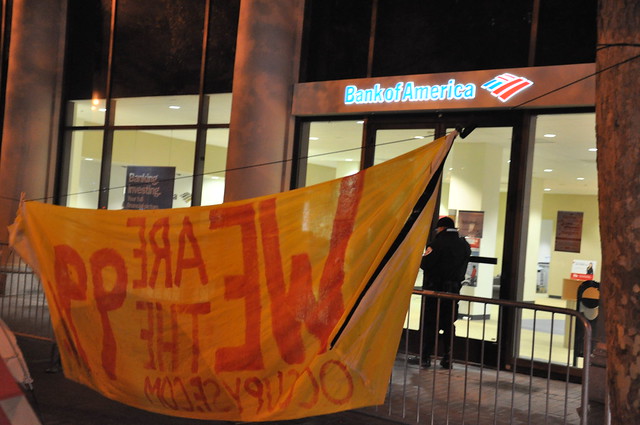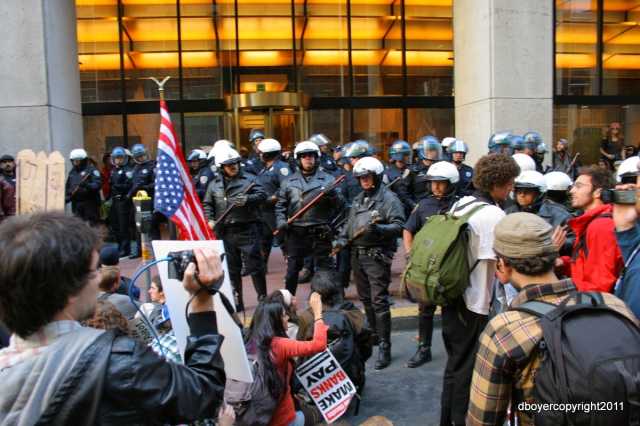This was going to be my week off from Occupying, but it didn’t work out that way.
 |
| Photo courtesy Steve Rhoads via flickr |
Late Sunday/early Monday I got the text message that Occupy Oakland was being evicted. I rushed down there, even though I knew it would probably be hours before the raid, which it was. So I went to work Monday with a scant two hours of sleep. Tuesday night I rushed over to Cal after work to catch the end of their Day of Action, Robert Reich giving the Mario Savio Lecture to an assembled 5,000 or so people crammed into Sproul Plaza. Wednesday I spent my lunch hour marching around the San Francisco Financial District with a spirited student-led demonstration demanding that California refund public education; Thursday at lunch I responded to an alert to go to a protest in support of Pancho Ramos Stierle, who was arrested at Occupy Oakland and turned over the Immigration; that one, as far as I could tell, did not happen, but at least the cops seemed as confused as I was.
Thursday night we heard that Occupy SF was expecting a raid, so I went over after work, decided I needed warmer clothes so went home, changed, ate dinner and drove back to the City, just in time to get the text saying they didn’t expect a raid after all. Stayed an hour and left.
Yesterday, I marched around Oakland for hours with a few thousand others, marched right past my own house twice, fought the temptation to duck out and go curl up in front of the heater with my cat and a cup of tea. Good rally at one of the five schools slated for closure at the end of this year, although a friend pointed out that a big majority of teachers and parent activists are women and all the ones who spoke were men.
 |
| Photo courtesy Bradley Stuart and Indybay |
Then we marched back to 19th and Telegraph where we knocked down a hastily erected fence around the big empty lot and park and established a new, beautiful Occupy Oakland camp. They set up the sound system and played dance music and chanted "Evict us and we multiply/Hella Hella Occupy." It started to pour. By the time I got home, I was so stiff I could barely move. I changed into dry clothes, put dinner in the oven and curled up with a book about the Free Speech Movement. People who are constantly criticizing the Occupy movement’s ultrademocratic process as producing a garbled message, should check out this book. People like Cal Student Advisor Faye Lawson, who allegedly participated in FSM and was onKCBS radio saying,
“Mario spoke with one voice, and he listened…. I think this movement needs direction. They need a speaker and they need to come together as a cohesive group with one voice and one mission…Then they can negotiate what they want on the table, what they want from us.”
Here’s a quote from FSM Steering Committee member Patti Iiyama, about the day that the students surrounded the police car on Sproul Plaza in 1964, when Savio and a few other “leaders” made an agreement with the administration to abandon the sit-in:
“Our first reaction was ‘My God! He had no right to make that agreement without coming back and taking a vote of everybody sitting around the car,’ because here we were willing to get our heads bashed in, and Mario and several other people had signed this agreement.”
And here’s FSM Executive Committee member, Andy Wells, talking about events a couple months later (this is in the chapter entitled “Internal Combustion”):
“We felt [the Steering Committee] were moving too fast without consulting the student body and there wasn’t enough communication between the Executive Committee and the Steering Committee. We felt that though we agreed with a lot of the proposals, the Steering Committee was very skilled in parliamentary maneuverings and it seemed that an awful lot of railroading was going on. … It seemed like a lot of secrecy was going on…Jack Weinberg and Mario and particularly Steve Weissman …defeated some proposals that we thought were pretty sound.”
This is not to say that the FSM was any more screwed up than many other groups, or that Occupy does everything right. It’s not to dispute that “horizontal” groups are always more democratic than groups with clearly defined leadership, or that consensus can’t be manipulated just as much as Robert’s Rules of Order (which my friends who have experience in labor unions call Robot’s Rules) can. In my considerable experience with groups that are “horizontal” or practice “pure democracy,” there’s always covert leadership, and a lot of times it’s self-appointed by those who have endless hours to spend in meetings, without the accountability that can come from elections, and with no ability to correct for things like the disproportionate influence of white men. A friend who has been heavily involved in Occupy Oakland, and comes out to every march and camp defense, referred to the Oakland General Assembly as a “dudefest.”
My opinion is that every popular movement embodies both a real human drive for democracy and the limitations of most forms of democracy. Except in very small groups where everyone knows each other very well and are completely on the same page politically, it can be painfully slow to make decisions by consensus. If you try to short-cut it by using majority or supermajority vote, people end up feeling disempowered and if they end up on the wrong side of the vote more than a couple times, they are likely to walk away. But people who can’t stick out the long process of reaching consensus are equally likely to walk away.
A lot of groups I’ve been in recently have adapted something I call faux-consensus, where decisions are officially made by “consensus” but we also have an agreement to keep meetings short, so everything that doesn’t reach consensus easily is either tabled or resolved in some technocratic way, like being turned over to a “working group” or relegated to a Parking Lot (a piece of butcher paper for things you’re not actually going to deal with in the meeting). So that gives the impression of everyone’s concerns being addressed, but really it’s just a way of shoving aside what the organizers of the meeting, who made the agenda, didn’t think was important. What is really going on is that the important decisions have been made before anyone walked into the meeting and the only real role for people who come to it is to take on a few discrete tasks that the organizers don’t feel they need to control and recruit others for the action.
Okay, that was a long digression into something that’s been on my mind a lot – this rabid obsession with trashing the leaderlessness of the Occupy movement (though one article I read recently called it “leaderfull” which I think is both accurate and lovely). But back to the chronology of my break from Occupying:
At midnight, I put down the FSM book, having just gotten to the part where the negotiations with the administration fell apart and the students were setting up their illegal tables again on Sproul Plaza (hilarious to me, because those tables have been a fixture of the campus since I started school there in 1980, and the order of things has hardly come crashing down). I watched a rerun of “Grey’s Anatomy.” At 1:00 am I turned off the TV and was about to go to bed when I got a text message – “OccupySF call for support; come defend 101 market; cops in riot gear NOW staging a few blocks away.” I grabbed my car keys, though I knew there was a good chance it would be over by the time I got there, which it more or less was. The cops were blocking access to the Market Street encampment, and even though my work ID got me close, I couldn’t really see. My friend David and I walked around with a couple heavy “Make the Banks Pay” banners, in hopes of injecting a little on-point messaging into an otherwise pretty unfocused scene. I stayed about an hour, long enough to get wet and cold again.
I got home around 3:00 and went to sleep. At 8:06, I got another text: “Riot cops at Occupy Oakland GET HERE NOW!!! 20 minute warning for raid.” I dressed and drove the few blocks to the new camp. It wasn’t raining so I didn’t take my rain jacket. Nearly all the tents, art, equipment was gone from the space by the time I got there. A line of riot cops was standing at the edge of the park, and every five minutes they would move about ten yards closer to the people who were frantically disassembling tents. It started to rain again. At the end, with the cops encroaching, I helped carry out the last two improvised tents. We didn’t have time to take them apart, so one person took each pole as if it were a chupah, a Jewish wedding canopy. As the cops pressed us the last few yards out of the park, supporters showed up with coffee and oatmeal for the campers, who drank and ate it in the street under a rainbow.
They chanted “Whose rainbow? Our rainbow.”







